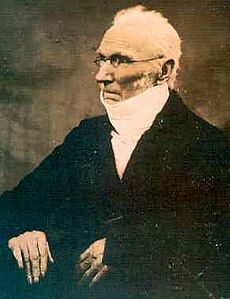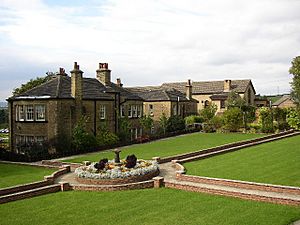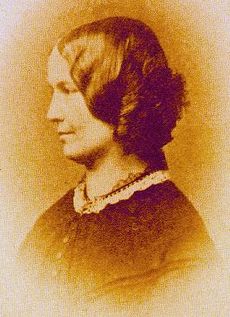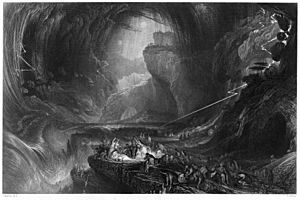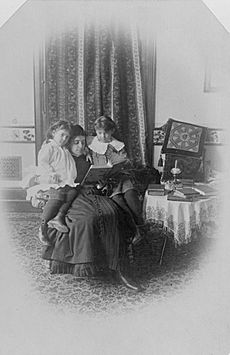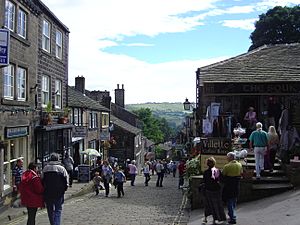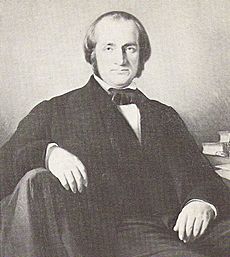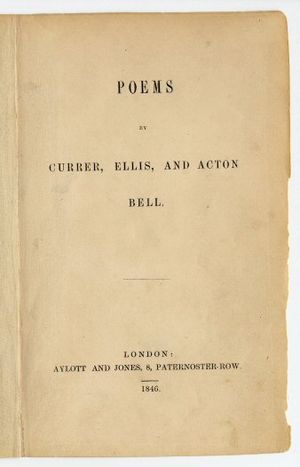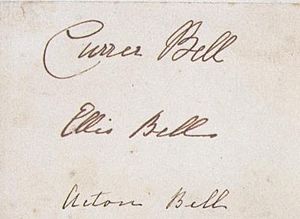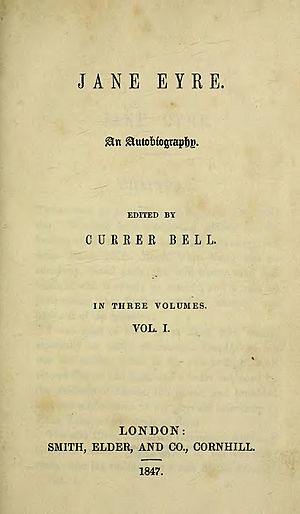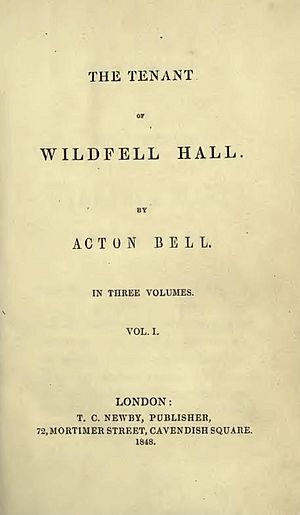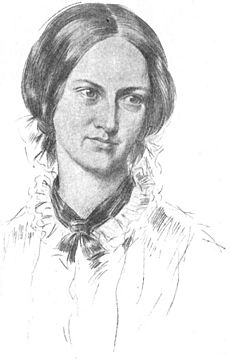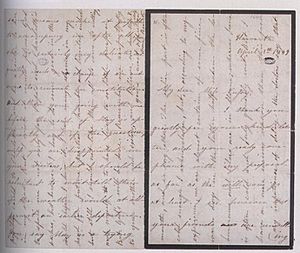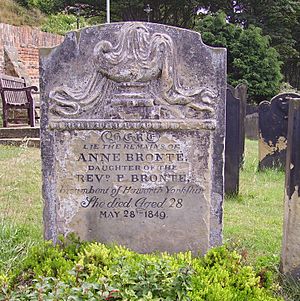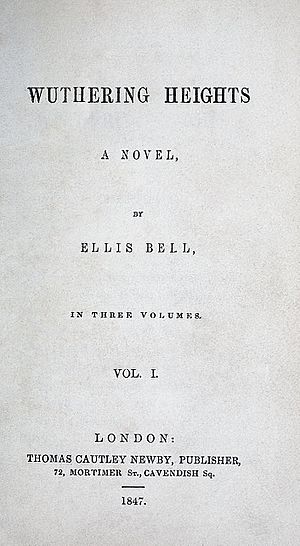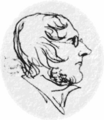Brontë family facts for kids
The Brontës (pronounced BRON-tees) were a famous family of writers who lived in England in the 1800s. They were born in a village called Thornton and later lived in Haworth, Yorkshire. The three sisters, Charlotte (1816–1855), Emily (1818–1848), and Anne (1820–1849), are known for their amazing poems and novels.
Like many women writers at the time, they used male pen names to publish their works: Currer, Ellis, and Acton Bell. Their stories were very exciting and original. Charlotte's Jane Eyre was the first to become popular. Later, Emily's Wuthering Heights and Anne's The Tenant of Wildfell Hall also became famous.
The three sisters and their brother, Branwell (1817–1848), were very close. As children, they loved to tell stories and play make-believe games, creating their own detailed imaginary worlds. They also wrote many complex stories together about these worlds. The deaths of their mother and two older sisters, and their quiet upbringing, deeply affected their writing. They grew up in a religious family. Today, their birthplace in Thornton and their home in Haworth, which is now the Brontë Parsonage Museum, are visited by many people each year.
Contents
- The Brontë Name
- The Brontë Family Members
- Education and Early Life
- Literary Beginnings
- Brontë Sisters' Literary Career
- Charlotte Brontë
- Branwell Brontë
- Emily Brontë
- Anne Brontë
- Northern England in the Brontës' Time
- The Brontë Sisters' Place in Literature
- Descendants
- The Brontës in Popular Culture
- Images for kids
- See also
The Brontë Name
The Brontë family name comes from an old Irish family called Ó Pronntaigh. This name means "descendant of Pronntach," and it belonged to a family of writers and scribes in Ireland.
At some point, the sisters' father, Patrick Brontë (who was born Patrick Brunty), changed the spelling of his name to Brontë. He added two dots over the 'e' to show that the name has two syllables (Bron-tee). People have different ideas why he changed it. He might have wanted to hide his humble beginnings. As a well-read man, he knew classical Greek and might have chosen the name from the Greek word for "thunder" (βροντή). Another idea is that he wanted to connect himself to famous people like Admiral Horatio Nelson, who was also known as the Duke of Bronté.
The Brontë Family Members
Patrick Brontë
Patrick Brontë (1777–1861) was the father of the Brontë sisters. He was born in Ireland to a family of farm workers. His birth name was Patrick Prunty or Brunty.
He was a very smart young man and earned a scholarship to St John's College, Cambridge. There, he studied religion and history. Going to Cambridge might have made him feel his name sounded too Irish, so he changed it to Brontë. He was ordained as a minister in 1806. He also wrote poems and articles.
In 1812, Patrick married Maria Branwell. By 1820, they had moved to the parsonage (the minister's house) in Haworth, where he became the local minister. They had six children. When his wife died in 1821, his sister-in-law, Elizabeth Branwell, came to help him raise the children. Patrick was dedicated to educating his children. He bought them many books and toys and gave them a lot of freedom and love.
Patrick lived a long life, outliving all his children. He died in 1861 at the age of 84. His son-in-law, Arthur Bell Nicholls, helped him in his later years.
Maria, née Branwell
Patrick's wife, Maria Brontë, née Branwell (1783–1821), was born in Cornwall. She came from a comfortable middle-class family. Maria died at the age of 38 from cancer. She was a well-read and religious woman, known for her lively and kind spirit. She designed embroidery patterns that her children stitched, which are now in the museum. Charlotte, her oldest surviving child, remembered her as a very energetic woman. The younger children, Emily and Anne, only had faint memories of their mother, especially of her suffering when she was ill.
Elizabeth Branwell
Elizabeth Branwell (1776–1842) was Maria's older sister. She arrived from Cornwall in 1821, after Maria's death, to help Patrick care for the children. She was known as 'Aunt Branwell'. Aunt Branwell taught the children arithmetic, the alphabet, and sewing skills. She also gave them books and subscribed to magazines, which gave them plenty to discuss. She was a kind person who dedicated her life to her nieces and nephew. She never married or returned to Cornwall. When she died in 1842, she left her three nieces a good sum of money (£900, which would be worth a lot more today). This money allowed them to leave their low-paying jobs as governesses and teachers.
The Brontë Children
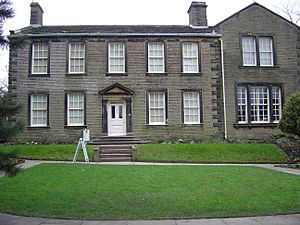
- Maria (1814–1825): The oldest child. She faced difficult conditions at Cowan Bridge School and became very ill. She died at home in Haworth at age 11 from tuberculosis. Charlotte described her as very lively and advanced in her reading.
- Elizabeth (1815–1825): The second child. She also attended Cowan Bridge School and became ill. She died at age 10, shortly after returning home.
- Charlotte (1816–1855): Born in Thornton. She was a poet and novelist, famous for Jane Eyre. She died just before her 39th birthday.
- Patrick Branwell (1817–1848): Born in Thornton. Known as Branwell, he was a painter, writer, and casual worker. He died in Haworth at age 31.
- Emily Jane (1818–1848): Born in Thornton. She was a poet and novelist. Her only novel was Wuthering Heights. She died in Haworth at age 30.
- Anne (1820–1849): Born in Thornton. She was a poet and novelist. She wrote Agnes Grey and her more ambitious novel, The Tenant of Wildfell Hall. She died in Scarborough at age 29.
Education and Early Life
Cowan Bridge School
In 1824, the four oldest girls (Maria, Elizabeth, Charlotte, and Emily) went to the Clergy Daughters' School at Cowan Bridge. This school was for children of ministers who didn't have much money. The next year, Maria and Elizabeth became very ill and were sent home, but they both died soon after. Charlotte and Emily were also taken out of the school. Charlotte later wrote about her difficult experiences at Cowan Bridge in her novel Jane Eyre, where the school became "Lowood."
The illness that affected Maria and Elizabeth, tuberculosis, also caused the deaths of Branwell, Emily, and Anne years later.
Patrick Brontë tried his best to find a good school for his daughters, but as a middle-class family without many connections, he couldn't afford expensive schools. He chose "charity schools" that offered lower fees. He believed the Clergy Daughters' School would be good for his daughters because it had respected supporters.
John Bradley
Around 1829–1830, Patrick Brontë hired John Bradley, a local artist, to teach his children drawing. Bradley was known in the area and likely encouraged Branwell's interest in art.
Miss Wooler's School
In 1831, 14-year-old Charlotte went to Miss Wooler's school in Mirfield. Patrick chose this school because Miss Wooler had a good reputation. Charlotte was happy there and studied well. She made lifelong friends, including Ellen Nussey and Mary Taylor. Charlotte returned home in 1832, happy to be with her family again.
Three years later, Miss Wooler offered Charlotte a job as her assistant. The family decided Emily would go with her to study, with Charlotte's salary helping to pay the fees. Emily was 17 and it was her first time away from Haworth since Cowan Bridge. Emily didn't settle well at the school; her health seemed to get worse, and she had to go home after three months. Anne took her place and stayed until Christmas 1837.
Charlotte kept busy by following the imaginary world of Angria, which she and Branwell had invented. She wrote long stories during her holidays.
Literary Beginnings
The Brontë children became interested in writing at a young age, starting it as a game. They all had a talent for storytelling. Their creativity began with twelve wooden soldiers that Patrick Brontë gave to Branwell in 1826. They called these toy soldiers "the Young Men" and gave them names.
In 1827, their ideas turned into written stories about an imaginary African kingdom called Glass Town, which later became the Empire of Angria. Emily and Anne created their own imaginary world called Gondal, an island continent ruled by a woman. These early stories were written in tiny "little books," about the size of a matchbox. The pages were filled with tiny, close writing, often without punctuation, and decorated with illustrations, maps, and plans. The idea was that the books were small enough for the toy soldiers to read.
Their stories became more complex as they grew up, influenced by the magazines and newspapers their father subscribed to.
Influences on Their Writing
Their fictional worlds were born from their vivid imaginations, fueled by reading and discussions.
Newspapers and Magazines
The magazines and newspapers Patrick Brontë read were a treasure trove of information for his children. Blackwood's Magazine, in particular, gave them knowledge about world events and ideas for their early writing. For example, an article about exploring central Africa, with a map, inspired geographical features in their tales.
Lord Byron
From 1833, Charlotte and Branwell's Angrian stories started to feature "Byronic heroes." These are characters who are very magnetic and passionate, but also arrogant and sometimes dark. The Brontës learned about the poet Lord Byron from Blackwood's Magazine. His influence can be seen in characters like Heathcliff in Wuthering Heights and Mr. Rochester in Jane Eyre. Other stories, like The Thousand and One Nights, also inspired them, adding exotic touches to their kingdoms.
John Martin
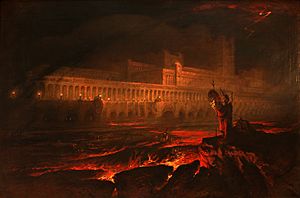
The children's imaginations were also shaped by three prints of engravings by John Martin from around 1820. Charlotte and Branwell copied these prints, which hung in their home. Martin's fantastic buildings appear in their Glass Town and Angrian writings. John Martin, along with Byron, was a key artistic influence on the Brontës' imaginary worlds.
Anne's Moral Stories
Anne's novels, Agnes Grey and The Tenant of Wildfell Hall, were strongly influenced by her experiences as a governess and her brother's struggles. They also show her belief that books should teach moral lessons, a conviction she shared with her father. This sense of moral duty is very clear in The Tenant of Wildfell Hall.
Many novels of the time, like those by John Bunyan and Daniel Defoe, influenced the Brontës. These stories often feature a hero or heroine who starts in poverty, faces many challenges, and eventually finds happiness. Charlotte's and Anne's main characters often follow this path, finding happiness in love and good deeds rather than just money. Wuthering Heights, however, is different. It's like a Greek tragedy with powerful emotions, similar to the works of John Milton and William Shakespeare. The Brontës also loved the novels of Walter Scott.
Governess Experiences and School Idea
Early Teaching Jobs
Because their father's income was modest, the Brontë girls had limited career choices: marriage, or becoming a schoolmistress or a governess. A governess was a woman who lived with a wealthy family and educated their children. The Brontë sisters found jobs teaching children, who were sometimes rebellious.
Emily was the only sister who never became a governess. Her only teaching experience was a difficult six months at a school called Law Hill. Charlotte taught at Miss Margaret Wooler's school and later in Brussels. She also worked as a governess for several families. Anne worked as a governess for Mrs. Ingham and then for Mrs. Robinson, where she even found a job for her brother Branwell to try and help him.
Working as Governesses
The family's money was tight, and Aunt Branwell was careful with her spending. Emily deeply missed her home and the moors when she was away, and she would become sad and unwell. Charlotte and Anne were more practical and didn't hesitate to find work. From 1839 to 1841, they worked as governesses for several months at a time. Anne stayed with the Robinsons for a longer period, from 1840 to 1845.
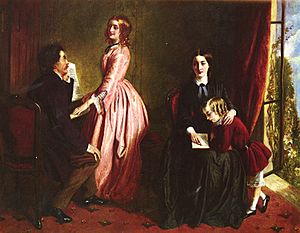
Charlotte then had an idea: she thought she and her sisters had the intelligence to open their own school for young girls at the parsonage. They planned to teach modern languages, so they decided to study abroad first. They considered Paris and Lille but chose Brussels, Belgium, where they could also study German and music. Aunt Branwell provided the money for this trip.
Study Trip to Brussels
Charlotte's and Emily's Journey to Brussels
Emily and Charlotte arrived in Brussels in February 1842 with their father. They enrolled in Monsieur and Madame Héger's boarding school for six months. Monsieur Héger taught the advanced French classes and was known for his brilliant mind and passionate teaching style.
Charlotte loved Monsieur Héger's lessons, and both sisters showed exceptional intelligence. Emily, however, didn't like her teacher much and was a bit rebellious. Emily quickly learned German and piano. After six months, Madame Héger offered them free room and board in exchange for teaching lessons. The girls accepted.
Return to Haworth
The death of their aunt in October 1842 forced them to return to Haworth. Aunt Branwell had left her money to her nieces, which helped them pay off debts and gave them some savings. The Hégers asked them to return to Brussels to teach English (Charlotte) and music (Emily). However, only Charlotte returned to Belgium in January 1843. Emily remained critical of Monsieur Héger, even though he thought highly of her, saying she "had the spirit of a man."
Charlotte Returns Home
After about a year, Charlotte, who had developed feelings for Monsieur Héger, resigned and returned to Haworth. Her time at the school had been difficult. During her absence, her father had lost his sight, though he later had successful surgery. It was while she was with him in Manchester in 1846 that Charlotte began writing Jane Eyre. Meanwhile, her brother Branwell's health rapidly declined. Partly because of Branwell's poor reputation, the plan for their own school failed and was abandoned.
Charlotte wrote four long, personal letters to Monsieur Héger, but he never replied. The depth of Charlotte's feelings for him wasn't fully known until her letters were published in 1913. Monsieur Héger had torn them up, but his wife saved the pieces and carefully glued them back together.
Brontë Sisters' Literary Career
First Publication: Poems
The sisters continued writing from a young age. Charlotte had ambitions like her brother. She sent some of her poems to the famous poet Robert Southey, but he replied that literature, especially poetry, was not a suitable occupation for ladies.
However, Charlotte didn't give up. One day in 1845, she found a small notebook of Emily's poems and was amazed by their beauty. Emily was initially upset that Charlotte had read her private poems, but after some time, she agreed to publish them.
Charlotte suggested a joint publication of poems by all three sisters. Anne easily agreed. They chose nineteen poems by Charlotte and twenty-one each by Anne and Emily. Charlotte then looked for a publisher. They found a small publishing house, Aylott & Jones, in London, who agreed to publish the book but at the authors' own risk. The book, titled Poems, was published in 1846 under the male pseudonyms Currer (Charlotte), Ellis (Emily), and Acton (Anne) Bell. They chose these names to keep their initials and possibly took "Bell" from their local minister, Arthur Bell Nicholls.
The book didn't get much attention; only three copies were sold. However, the sisters continued to write their novels in secret, often discussing their stories at the dinner table.
Rising Fame
1847
Charlotte's Jane Eyre, Emily's Wuthering Heights, and Anne's Agnes Grey were all published in 1847 after a long search for publishers. Jane Eyre was published by Smith, Elder & Co. Emily's and Anne's novels were published together by Thomas Cautley Newby.
Wuthering Heights and Agnes Grey received mixed reviews, but Jane Eyre quickly became a best-seller, even though some critics found it controversial.
Jane Eyre and Growing Fame
The publication of Jane Eyre under the name Currer Bell made Charlotte famous. In July 1848, Charlotte and Anne (Emily refused to go) traveled to London to prove to their publisher, Smith, Elder & Co., that they were three separate authors. This was because another publisher had spread a rumor that all three novels were written by one person, Ellis Bell (Emily). George Smith, their publisher, was very surprised to meet two shy, simply dressed country girls. He introduced them to his mother and invited them to the opera.
Wuthering Heights
Emily Brontë's Wuthering Heights was published in 1847 under the name Ellis Bell. It was controversial from the start due to its unique style and intense story. Some critics disliked it, but it sold well for an unknown author.
The novel is a dark Romantic story set in the wild countryside, contrasting two places: the refined Thrushcross Grange and the wild, crumbling Wuthering Heights. The characters are passionate and sometimes violent. The story is told by two narrators, making it complex and engaging.
1848: Anne's The Tenant of Wildfell Hall
A year before her death, Anne published her second novel, The Tenant of Wildfell Hall. It was more ambitious than her first and quickly sold more copies than Emily's Wuthering Heights. However, critics had mixed feelings, some praising its power and others calling it "coarse." Charlotte herself thought the subject choice was a mistake. After Anne's death, Charlotte prevented the novel from being republished, which made Anne less known for a time.
Today, The Tenant of Wildfell Hall is seen by many as one of the first important feminist novels.
Identities Revealed
In 1850, after Emily and Anne had passed away, Charlotte wrote a preface for a new edition of Wuthering Heights and Agnes Grey. In this preface, she publicly revealed the true identities of all three sisters.
Charlotte Brontë
Boarding School Experiences in Jane Eyre
The conditions at Cowan Bridge School, where Maria and Elizabeth may have caught the illness that led to their deaths, were probably similar to many schools of that time. However, Charlotte blamed Cowan Bridge for her sisters' deaths, especially the poor medical care and neglect. Charlotte's strong memories of the hardships at Cowan Bridge inspired her description of Lowood School in Jane Eyre. She wrote about the small portions of spoiled food, lack of heating and proper clothing, frequent illnesses, and harsh punishments.
Literary Friends
After the huge success of Jane Eyre, Charlotte's publisher encouraged her to visit London to meet her readers. Despite being very shy, Charlotte agreed. In London, she met other great writers of the time, including Harriet Martineau and William Makepeace Thackeray, who became her friends. Charlotte greatly admired Thackeray.
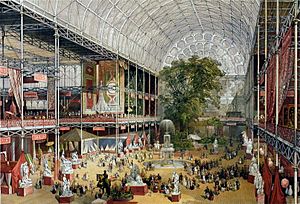
In 1851, she visited the Great Exhibition and The Crystal Palace in London. She also published Shirley in 1849 and Villette in 1853.
Marriage and Death
The Brontë sisters found the local ministers quite amusing. Arthur Bell Nicholls (1818–1906), who had been a minister in Haworth for seven and a half years, surprised everyone by proposing to Charlotte. Her father was very angry about this. Charlotte was impressed by Nicholls's dignity and deep voice, but she found him rigid and conventional. After she first turned him down, Nicholls left his job for several months. However, Charlotte's feelings slowly changed, and after convincing her father, she finally married Nicholls on June 29, 1854.
After their honeymoon in Ireland, Charlotte's life changed completely as she took on her new duties as a wife. She wrote to her friends that Nicholls was a good and caring husband, but she felt a "holy terror" about her new situation. She died the following year at age 38. The cause of death was likely tuberculosis, possibly made worse by typhoid fever (due to poor sanitation in Haworth) and severe morning sickness from her early pregnancy.
The first biography of Charlotte was written by Elizabeth Gaskell in 1857. This book helped create the idea of the Brontës as a family of brilliant writers living in quiet, romantic solitude.
Charlotte's Novels
- Jane Eyre (1847)
- Shirley (1849)
- Villette (1853)
- The Professor (1857)
Unfinished Writings
Charlotte left behind some unfinished stories:
- Ashford (1840–1841): Features characters from her imaginary world of Angria in a realistic setting.
- Willie Ellin (1853): A vague story in three parts.
- The Moores: An outline for two short chapters with two brothers as characters.
- Emma: A brilliant fragment published in 1860, which later inspired the novel A Little Princess.
- The Green Dwarf (published 2003): Likely inspired by Walter Scott's novel The Black Dwarf. It's a fictional history about a war between Verdopolis (the capital of Glass Town) and Senegal.
Branwell Brontë
Patrick Branwell Brontë (1817–1848) was considered a genius by his father and sisters. He was intelligent and talented, especially in literature. He often led the Brontë siblings in creating their imaginary worlds. He was also an artist, encouraged by his father.
He tried to become a famous artist in London but spent his money quickly. His attempts to find low-paying jobs failed.
Anne Brontë helped him get a job in 1843, but he was dismissed almost three years later. In September 1848, after several years of declining health, he died from tuberculosis at age 31. His father sadly called him "My brilliant boy," and Emily, who was very loyal, wrote that his condition had been "hopeless."
Branwell wrote many stories as a child with Charlotte, including Glass Town and Angria. He also wrote poems and prose under the pen name Northangerland.
Emily Brontë
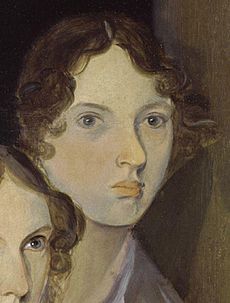
Emily Brontë (1818–1848) has been called the "Sphinx of Literature" because she wrote for her own satisfaction, not for fame. She was extremely shy outside her family, sometimes turning away from people without speaking.
With just one novel, Wuthering Heights (1847), and powerful poems, she reached great literary heights. Although she was almost unknown during her lifetime, she is now considered one of the greatest English writers.
Above all, Emily loved to wander the wild moors around Haworth. In September 1848, her health quickly worsened. She had tuberculosis but refused most treatments. Despite a popular story, she did not die on the dining room sofa. Charlotte's letters mention Emily's dog, Keeper, by her deathbed. It's possible she left an unfinished manuscript that Charlotte later burned to avoid controversy, but there's no proof of this.
Emily Brontë's Poems
Emily's poems were likely written to be part of her Gondal saga, an imaginary world she continued to identify with even as an adult. She would act out scenes from her "little books" with Anne. "Remembrance" was one of her 21 poems chosen for the 1846 joint publication with her sisters.
Anne Brontë
Anne was not as famous as her other two sisters. Her second novel, The Tenant of Wildfell Hall, was prevented from being republished by Charlotte after Anne's death. Charlotte wrote to her publisher that the subject of the book was a "mistake" and "too little consonant with the character, tastes and ideas of the gentle, retiring inexperienced writer." This decision is considered the main reason Anne is less known than her sisters today.
Anne's health began to decline quickly, like her brother and sister's. On April 5, 1849, she wrote to her friend Ellen Nussey, asking her to come with her to Scarborough on the east coast. Anne shared her thoughts with Ellen:
I have no horror of death: if I thought it inevitable I think I could quietly resign myself to the prospect ... But I wish it would please God to spare me not only for Papa's and Charlotte's sakes, but because I long to do some good in the world before I leave it. I have many schemes in my head for future practise—humble and limited indeed—but still I should not like them all to come to nothing, and myself to have lived to so little purpose. But God's will be done.
Anne hoped the sea air would improve her health, as her doctor suggested, and Charlotte agreed to go with her.
On Sunday morning, Anne felt weaker and asked to be taken back to Haworth. The doctor confirmed she was close to death, and Anne thanked him for his honesty. "Take courage, take courage," she whispered to Charlotte. She died at 2 p.m. on Monday, May 28. She is buried in the cemetery of St Mary's of Scarborough. Her gravestone had an error in her age; she died at 29, not 28. Charlotte noticed this during her only visit and intended to have it corrected, but she became ill and couldn't. The tombstone remained incorrect until it was replaced in 2013.
Northern England in the Brontës' Time
In her 1857 biography The Life of Charlotte Brontë, Elizabeth Gaskell described the wild countryside of Yorkshire, the small village of Haworth, and the parsonage and church surrounded by a large cemetery on a hill. She also wrote about the social, health, and economic conditions of the region.
Haworth's Conditions
The many deaths in the Brontë family were not unusual for the area, where people faced death daily. When Patrick Brontë arrived, many people in the parish were unemployed. The village had no sewage system, and the well water was contaminated. Life expectancy was less than 25 years, and many babies died young. Most people lived by farming the poor land of the moors and earned extra money by spinning and weaving wool at home. Conditions changed as the textile industry grew, with mills built along the River Worth.
Food was often scarce, sometimes just porridge, leading to vitamin deficiencies. Public hygiene was very basic. Charlotte, in her thirties, was described as having lost many teeth. However, the Brontë family generally had enough food. They ate plenty of porridge in the mornings, and Tabby, their maid, would peel piles of potatoes while telling local stories. Sometimes, Mr. Brontë would bring home game given by his parishioners.
Role of Women
According to the poet laureate Robert Southey, women from good families should be content with an education and marriage, along with some decorative talents. Patrick Brontë himself wrote in one of his works that women were not meant to study difficult subjects like Greek or math, but rather their strength was in "softness, tenderness and grace." However, this seemed to contradict his actions, as he encouraged his daughters' intellectual pursuits, even if he wasn't fully aware of all they did with their time.
The Brontë Sisters' Place in Literature
Because they lived quite isolated lives, the Brontë sisters formed a unique literary group. There isn't a clear "Brontë style" that was directly followed by other writers.
Their influence certainly existed, but it's hard to fully define. Writers who came after them, like Thomas Hardy and George Eliot, may have been inspired by their dark and emotional worlds. However, there isn't a specific literary movement that came from them.
Visits to Haworth Since 1860
By 1860, Charlotte had been dead for five years. In 1857, Elizabeth Gaskell's biography of Charlotte was published, causing a sensation across the country.
After the book came out, the parsonage became a popular place for admirers to visit. Charlotte's husband remembered having to protect his father-in-law from crowds of people wanting to touch him as they walked to church. Hundreds, then thousands, of visitors came from all over Britain and even from other countries. Patrick Brontë would politely meet them and tell stories about his brilliant daughters.
The number of visitors has continued to grow. In 2017, the parsonage in Haworth received about 88,000 visitors.
Brontë Society
The Brontë Parsonage Museum is managed by the Brontë Society. This society organizes exhibitions and preserves the family's belongings and documents. The society has branches in many countries around the world.
Haworth
In 1904, Virginia Woolf visited Haworth and wrote about it. She noted how the village and the Brontë sisters seemed to fit together perfectly, like a snail in its shell. She felt that the preserved objects and clothes helped people understand the sisters' unique lives.
Descendants
Patrick Brontë's direct family line ended with his children. However, Patrick's brother had notable descendants, including James Brontë Gatenby, a scientist, and Peter Gatenby, a medical director for the UN.
The Brontës in Popular Culture
Movies
- Three Sisters of the Moors (1944, American short film): Molly Lamont as Charlotte, Lynne Roberts as Emily, and Heather Angel as Anne.
- Devotion (1946, American film): Ida Lupino as Emily, Olivia de Havilland as Charlotte, and Nancy Coleman as Anne.
- Les Sœurs Brontë (1979, French film): Isabelle Adjani as Emily, Marie-France Pisier as Charlotte, Isabelle Huppert as Anne, Patrick Magee as Patrick Brontë, and Pascal Greggory as Branwell Brontë.
- Emily (2022, British/American film): Emma Mackey as Emily, Alexandra Dowling as Charlotte, and Amelia Gething as Anne.
Objects in Outer Space
- Asteroid #39427 is named Charlottebrontë.
- Asteroid #39428 is named Emilybrontë.
- Asteroid #39429 is named Annebrontë.
- A 60-kilometer-wide impact crater on the planet Mercury is named Brontë, in honor of the family.
Sport
- In 2018, a new horse race at York Racecourse was named the Brontë Cup to honor the family.
Images for kids
-
Anne, Emily, and Charlotte Brontë, by their brother Branwell (c. 1834). He painted himself among his sisters, but later removed his image so as not to clutter the picture.
National Portrait Gallery, London. -
View of St John's College, Cambridge, where Patrick Brontë was a student
-
Portrait of James Sheridan Knowles, in Fraser's Magazine 1838
See also
 In Spanish: Familia Brontë para niños
In Spanish: Familia Brontë para niños


